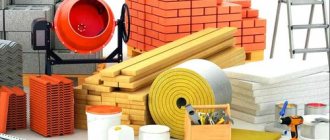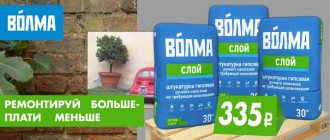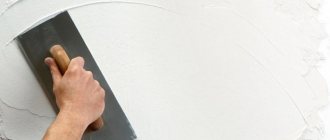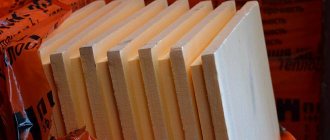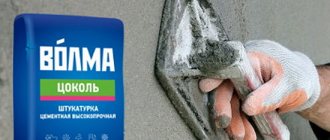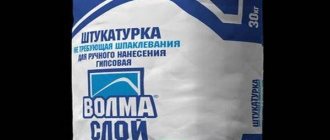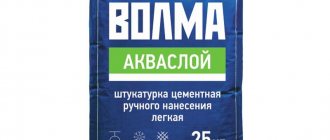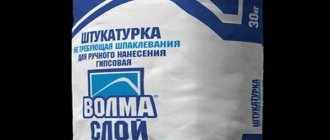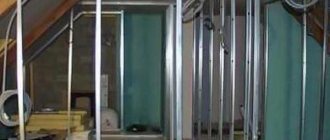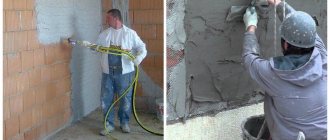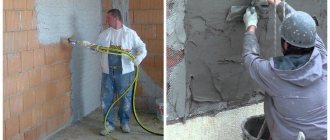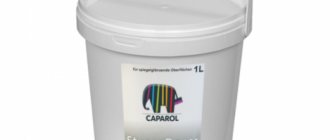Varieties of VOLMA plaster
The production line allows the production of several types of dry plaster mixtures:
Volma-Aquaslayer
Volma-Decor
Volma-Plast
Volma-Shov
- "Volma-Aquaslayer MN" - plaster is intended for application to surfaces by machine. Thanks to modified lightweight aggregates, Portland cement, mineral and synthetic additives, it has excellent physical characteristics. Can be used for leveling interior and exterior walls in rooms with high humidity conditions.
- "VOLMA-Sloy" - plasters for hand-made leveling of walls and ceilings. “VOLMA-Sloy-MN” plaster is designed to work with a machine unit.
- "VOLMA-Plast" - used as a base before the finishing coating or finishing material.
- “VOLMA-Decor” - thanks to a certain application technique, it can take any shape.
Volma Layer (New):
— gypsum is used as a binder;
— applied to the internal surfaces of premises for their further finishing;
— any cement-sand, gypsum, clay surfaces are used as bases;
— does not require subsequent priming and puttying;
- gives a shiny surface;
— bending strength from 1.0 MPa.
Application area of plaster
VOLMA plaster is used for leveling wall and ceiling surfaces, both manually and by machine, in interior spaces with subsequent finishing:
- laying ceramic tiles;
- wallpapering;
- painting without puttingty.
When carrying out plastering work, one should take into account the level of humidity inside the room and the temperature regime, which should be in the range from +5 C0 to +30 C0.
VOLMA plaster is very effective when carrying out restoration work and manufacturing decorative elements. If the application technology is followed, the result should be a smooth surface.
The result of applying Volma gypsum plaster
Volma-Layer Ultra (New):
— gypsum is used as a binder;
— applied to the internal surfaces of premises for their further finishing;
— any cement-sand, gypsum, clay surfaces are used as bases;
- resistant to cracking;
- gives a shiny surface;
— bending strength from 1.5 MPa.
Bases and surfaces on which Volma plaster can be applied
This plaster can be applied to various construction substrates:
- plasterboard and gypsum fiber sheets;
- brick;
- concrete;
- gas and foam concrete;
- gypsum blocks;
- chipboard;
- cement-lime plasters.
Technical specifications
- Drying time for plaster is up to 7 days;
- initial setting period – after 40 minutes;
- the final setting period is no later than 3 hours;
- The recommended layer height is up to 30 mm. Layers applied greater than this parameter are applied in two stages;
- maximum thickness of the plaster layer – 60mm;
- liquid consumption for the solution is 0.6 – 0.65 liters of water per 1 kg of mixture;
- plaster "VOLMA" mixture consumption per 1 m2 with a layer thickness of 1 mm - 1 kg;
“VOLMA” plaster, the price per layer of one application, which will be slightly more expensive than other domestic plasters, but this is compensated by the quality of the material, which is not inferior to Rotband, but much cheaper.
Preparing the base for plastering work
Before plastering, the base of the wall or ceiling should be very thoroughly cleaned of various layers, dust, oil stains, dirt and then dried. Detached areas must be strengthened, potholes must be repaired. If there are large irregularities, fungi and white salt deposits, they must be eliminated.
The result should be a smooth, rough surface and a stable, evenly absorbent, strong base. Protruding metal parts must be treated with an anti-corrosion compound. The surface to be plastered must not be frozen. The minimum base temperature for plastering work is +5 C0, the maximum humidity level is 5%.
Before applying “VOLMA - Layer” plaster, the base must be coated with a primer that matches the type of base. Based on the rate of moisture absorption, bases are divided into strongly, normally and weakly absorbent. It is recommended to apply VOLMA-Kontakt primer on weakly absorbent substrates, and VOLMA-Universal or VOLMA-Plast primer on highly absorbent substrates.
A guide corner profile is installed on the protruding outer corners of the wall or ceiling. It is fixed to the base using mounting adhesive or gypsum plaster. In this case, the solution is applied to the inside of the guides and to the surface of the corner of the base. The corner profile should be pressed against the wall first in the center, and then gradually transfer the pressure to the edges.
Technological process of working with “Volma – Layer” plasters
The required volume of water at room temperature is poured into a clean plastic container at the rate of 1 kg of mixture per 0.6 liters of liquid, and the gypsum mixture is poured. The solution is thoroughly mixed with a construction mixer until smooth and allowed to settle for several minutes.
The process of preparing gypsum plaster using a drill with a special “mixer” attachment.
After 20 minutes, the freshly obtained solution is applied to the prepared surface in a layer of 5-60 mm using a trowel. The applied mixture is leveled using the rule. After the initial coat has completely dried, a second coat can be applied if necessary. After 40-60 minutes after setting and drying, the surface is trimmed using the rule.
Twenty minutes after trimming, the resulting surface is sufficiently moistened with water using a sponge material and smoothed with a wide spatula. The result is a perfectly smooth surface, which is quite suitable for wallpapering. To prepare the surface for touch-up painting, after another 3 hours it is necessary to soak it generously with water and smooth it with a spatula. To decorate a wall with a pattern or texture, various painting and plastering tools are used: rollers, brushes, spatulas, trowels, sponge trowels. With their help, the surface, after leveling, is finished with a decorative pattern.
The drying period on the walls and ceiling is determined by the thickness of the plaster layer, humidity and temperature in the room and is approximately seven days. Supply ventilation will speed up this process.
LKMFLOT
Code: 100985640
Category:
Putties and Plasters
Brand:
Volma
Packing:
25
Package:
1
Volma-Aquaslayer Plaster
DESCRIPTION: “VOLMA-Aquaslayer” is a dry lightweight cement leveling plaster mixture based on Portland cement with light fillers, polymer and mineral additives that improve the performance properties of the solution, crack-resistant, fiber-reinforced, for manual application outside and inside the building.
AREA OF APPLICATION: For manual leveling of walls and ceilings, outside and inside buildings, including in rooms with high relative humidity. For preparing the surface of walls for tiling: in kitchens, shower rooms, saunas, etc., for applying decorative plasters and putties. It is not recommended to use for leveling and repairing floors.
TECHNICAL CHARACTERISTICS: Layer thickness allowed when sealing sinks, potholes on the surface up to 60 mm Recommended layer thickness for walls 10-30 mm Recommended layer thickness for ceilings 10 mm Maximum particle size 1.25 mm Viability of the finished solution in a container less than 2 hours Water consumption per 1 kg dry mixture 0.28-0.3 l Consumption of dry mixture with a layer thickness of 10 mm 11-12 kg/sq.m Compressive strength of at least 4.0 MPa Tensile strength in bending of less than 2.0 MPa Adhesion strength to the base (concrete) in age 28 days not less than 0.4 MPa Frost resistance F35 Water absorption when saturated with water for 48 hours and complete immersion of samples in water (for external use) less than 10% Vapor permeability resistance coefficient 0.1-0.15 mg/m h Pa Full cycle time 24 hours Operating temperature (for outdoor work) from -40C to + 60C
BASES: - concrete bases, including slag concrete, expanded clay concrete, foam-aerated concrete, - plastered with cement-sand, cement-lime compositions, - masonry made of ceramic and silicate bricks.
SURFACE PREPARATION: The base for plastering must comply with the requirements of SNiP 3.04.01-87 and be dry and durable. The “age” of brickwork must be at least 28 days, and concrete - at least 3 months. The surface must first be cleaned of various types of contaminants and substances that reduce the adhesion of the plaster solution to the base (fats, lubricating oils, bitumen mastics, glue, paint and varnish coatings, etc.). When reconstructing buildings, weak areas of old plaster (delamination from the base, etc.) must be removed from the walls. The prepared base made of ceramic or silicate brick must be primed with Volma-Universal primer. Prime concrete and other weakly absorbent smooth substrates with Volma-Contact primer. Bases made of foamed aerated concrete and other highly absorbent materials must be primed 1-2 times with VOLMA-Universal primer. At ambient temperatures above +30? C, it is recommended to moisten the base before applying plaster. The base temperature should not be lower than +5?C and not higher than +30?C. Places subject to the formation of cracks (for example, various structural materials located nearby, corners of holes, etc.) must be strengthened before plastering with a reinforced fiberglass mesh with 5x5 mm cells.
PREPARATION OF THE SOLUTION: Pour clean water into the container at the rate of 0.28-0.3 liters of water per 1 kg of mixture. Add the appropriate amount of dry mixture to a container with water. Mix the solution with a professional construction mixer at medium speed (600-800 rpm) to achieve a homogeneous plastic mass without lumps, add water if necessary. Then a technological pause of 3-5 minutes is maintained to “ripen” the mortar mixture, after which it is mixed again. At +20? C the mixture remains viable for at least 2 hours. As the temperature decreases, this time increases, and as the temperature rises, it shortens. Attention: Do not overdose on water, as excess water leads to peeling and loss of mechanical strength of the plaster, as well as the appearance of cracks on the surface.
APPLYING THE MORTAR MIXTURE: The finished mortar is evenly spread onto the prepared base with a trowel, trowel, plaster ladle or applied with a plaster trowel, then leveled using an h-shaped rule until a smooth surface is obtained. Check vertical deviations with a two-meter building level, not allowing deviations of more than 5 mm. After 20-24 hours from the moment the plaster layer is leveled, the plastered surface must be trimmed. Trimming is performed using a trapezoidal rule, holding it at an angle of 90 degrees to the surface being treated, and cutting off any irregularities. Then you need to moisten the cut surface and rub it with a felt or polyurethane grater. When using the latter, the surface becomes rougher.
CONDITIONS OF WORK: The applied material cannot be dried by force: using heaters, heat guns and other devices. When working on facades, freshly laid plaster should be protected from precipitation for three days, as well as from excessive drying and cooling. Do not begin finishing work in rain or strong winds.
STORAGE CONDITIONS: Store bags of dry mixture “VOLMA-Aquasloy” on wooden pallets in dry rooms. Pour the mixture from damaged bags into whole bags and use first. Guaranteed shelf life in undamaged original packaging is 12 months.
PACKING: 25 kg
Specifications
- Layer thickness allowed when sealing shells and potholes on the surface: up to 60 mm
- Recommended layer thickness for walls: 10-30 mm
- Recommended layer thickness for ceilings: 10 mm
- Maximum particle size: 1.25 mm
- Viability of the finished solution in containers: at least 2 hours
- Water consumption per 1 kg of dry mixture: 0.28-0.3 l
- Consumption of dry mixture with a layer thickness of 10 mm: 11-12 kg/sq.m
- Compressive strength: not less than 4.0 MPa
- Tensile strength when bending: not less than 2.0 MPa
- Strength of adhesion to the base (concrete) at the age of 28 days: not less than 0.4 MPa
- Frost resistance: F35
- Water absorption when saturated with water for 48 hours and samples are completely immersed in water (for outdoor use): less than 10%
- Vapor permeability resistance coefficient: 0.1-0.15 mg/m h Pa
- Full cycle time: 24 hours
- Operating temperature (for outdoor work): from -40C to + 60C
Light cement plaster “Volma-aquaslayer MN”, 25 kg (Cement-Active)
- +7 show number +79118403768
| Day | Working hours | Break |
| Monday | 09:30 — 17:30 | |
| Tuesday | 09:30 — 17:30 | |
| Wednesday | 09:30 — 17:30 | |
| Thursday | 09:30 — 17:30 | |
| Friday | 09:30 — 17:30 | |
| Saturday | Day off | |
| Sunday | Day off |
* Time specified for the region: Russia, St. Petersburg
Application area:
— For leveling walls and ceilings inside buildings, in rooms with normal and high relative humidity.
— It is a good base for tiling and applying decorative plasters.
— Especially recommended for rooms with increased sanitary requirements, due to its resistance to fungal infection.
— For machine application.
— Not intended for leveling and repairing floors.
Reasons:
— Concrete foundations, including monolithic and prefabricated structures
— Various masonry made of ceramic, silicate, foam, gas, slag, expanded clay concrete, and other masonry materials.
— New and old surfaces plastered with lime, cement-sand and cement-lime mortars.
Surface preparation:
The base for plastering must comply with the requirements of SNiP 3.04.01-87 and be dry and durable. The “age” of brickwork must be at least 28 days, and concrete - at least 3 months. The surface must first be dust-free and cleaned of various types of contaminants and substances that reduce the adhesion of the plaster solution to the base (fats, lubricating oils, bitumen mastics, glue, paints, etc.). When reconstructing buildings, weak areas of old plaster (delamination from the base, etc.) must be removed from the walls. It is recommended to fill masonry joints and deep irregularities in order to reduce the risk of shrinkage cracks. To prepare the base, it is recommended to first apply “VOLMA-Spray” with a thickness of 3 – 5 mm. Subsequent application of plaster is carried out after 6 - 8 hours. Before application, moisten the base thoroughly with water.
The base temperature should be from +5 to + 30ºС. Places subject to the formation of cracks (for example, various structural materials located nearby, corners of holes, etc.) must be strengthened before plastering with a reinforcing plaster mesh made of galvanized metal or fiberglass with cells of at least 7x7mm.
Preparation of the solution:
The mortar is prepared with a plastering machine, for example, KALETA A5, A4, A3, A2, or A1 or any other plastering unit of a similar type with a D6-3 gerotor pump. Before applying the solution to the surface to be treated, it is necessary to set the flow meter readings on the plastering machine to between 400 and 600 l/hour, depending on the required consistency. The solution retains its mobility in the mortar sleeves for 40 - 60 minutes. After finishing work, rinse the hoses for the solution with water.
Application and processing of plaster mortar:
Preparing the base
The base for plastering must comply with the requirements of SNiP 3.04.01-87 and be dry and durable. The “age” of brickwork must be at least 28 days, and concrete - at least 3 months. The surface must first be cleaned of various types of contaminants and substances that reduce the adhesion of the plaster solution to the base (fats, lubricating oils, bitumen mastics, glue, paint and varnish coatings, etc.). When reconstructing buildings, weak areas of old plaster (delamination from the base, etc.) must be removed from the walls. The prepared base made of ceramic or silicate brick must be primed with Volma-Universal primer. Prime concrete and other weakly absorbent smooth substrates with Volma-Contact primer. Bases made of foamed aerated concrete and other highly absorbent materials must be primed 1-2 times with VOLMA-Universal primer.
At ambient temperatures above +30oC, it is recommended to moisten the base before applying plaster. The base temperature should not be lower than +5oC and not higher than +30oC.
Places subject to the formation of cracks (for example, various structural materials located nearby, corners of holes, etc.) must be strengthened before plastering with a reinforced fiberglass mesh with 5x5 mm cells.
Execution of work
The finished solution is evenly spread onto the prepared base with a trowel, trowel, plaster ladle, or applied with a plaster trowel, then leveled using an h-shaped rule until a smooth surface is obtained. Check vertical deviations with a two-meter building level, not allowing deviations of more than 5 mm. After 20-24 hours from the moment the plaster layer is leveled, the plastered surface must be trimmed. Trimming is performed using a trapezoidal rule, holding it at an angle of 90 degrees to the surface being treated, and cutting off any irregularities. Then you need to moisten the cut surface and rub it with a felt or polyurethane grater. When using the latter, the surface becomes rougher.
The applied material cannot be dried by force: using heaters, heat guns and other devices.
When working on facades, freshly laid plaster should be protected from precipitation for three days, as well as from excessive drying and cooling. Do not begin finishing work in rain or strong winds.
Preparation of the solution
Pour clean water into the container at the rate of 0.28-0.3 liters of water per 1 kg of mixture. Add the appropriate amount of dry mixture to a container with water. Mix the solution with a professional construction mixer at medium speed (600-800 rpm) to achieve a homogeneous plastic mass without lumps, add water if necessary. Then a technological pause of 3-5 minutes is maintained to “ripen” the mortar mixture, after which it is mixed again.
At +20oC the mixture remains viable for at least 2 hours. As the temperature decreases, this time increases, and as the temperature rises, it shortens.
Attention: Avoid overdosing on water, as excess water leads to peeling and loss of mechanical strength of the plaster, as well as the appearance of cracks on the surface.
Volma-Akvaplast
— cement (based on Portland cement);
— for interior and exterior finishing of any building elements for further tiling;
— applied to bases made of concrete (including lightweight) and brick;
— can be used in damp rooms;
- applied manually;
— basic;
- resistant to cracking;
- reinforced;
— bending strength from 2.5 MPa.
Volma-Canvas
— gypsum is used as a binder;
— applied to the internal surfaces of premises for their further finishing;
— any cement-sand, gypsum, clay surfaces are used as bases;
- applied manually;
- forms a shiny surface;
— bending strength from 1.5 MPa.
